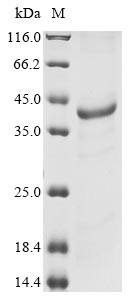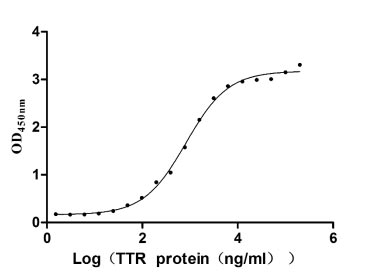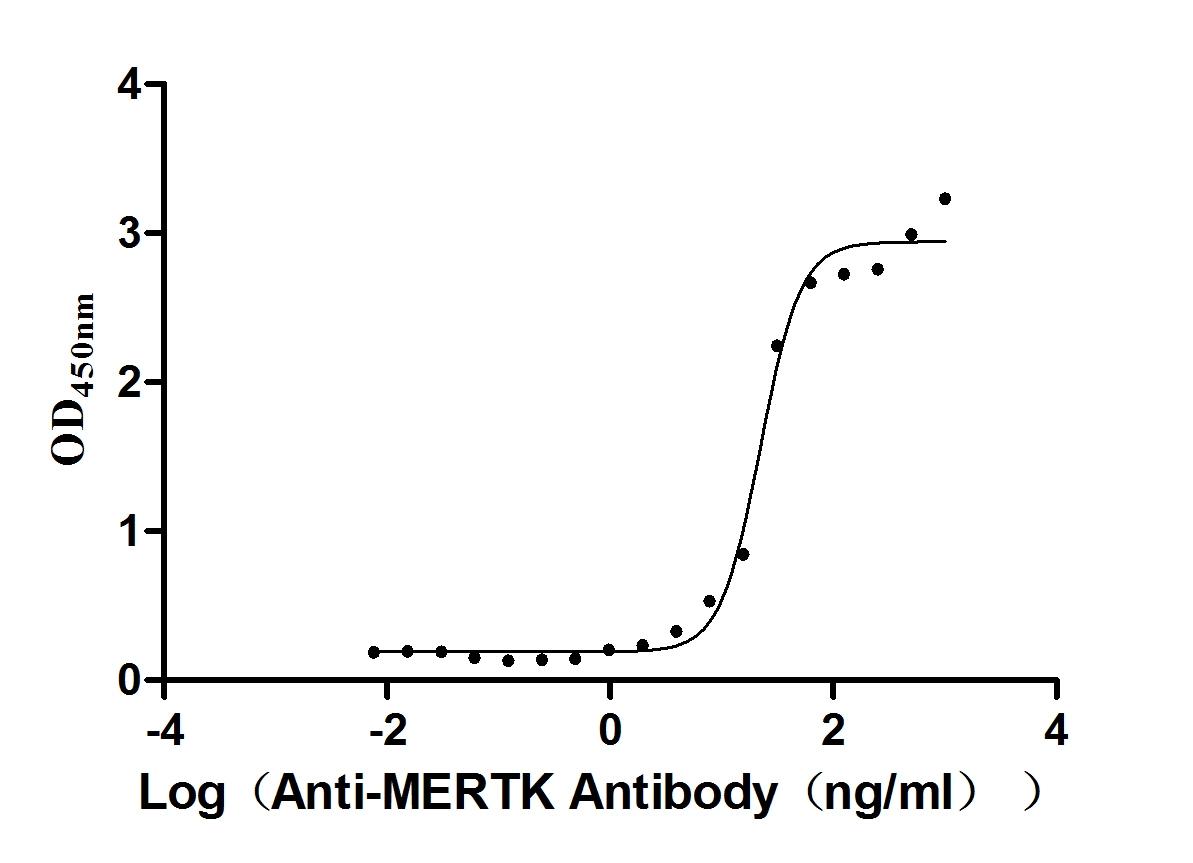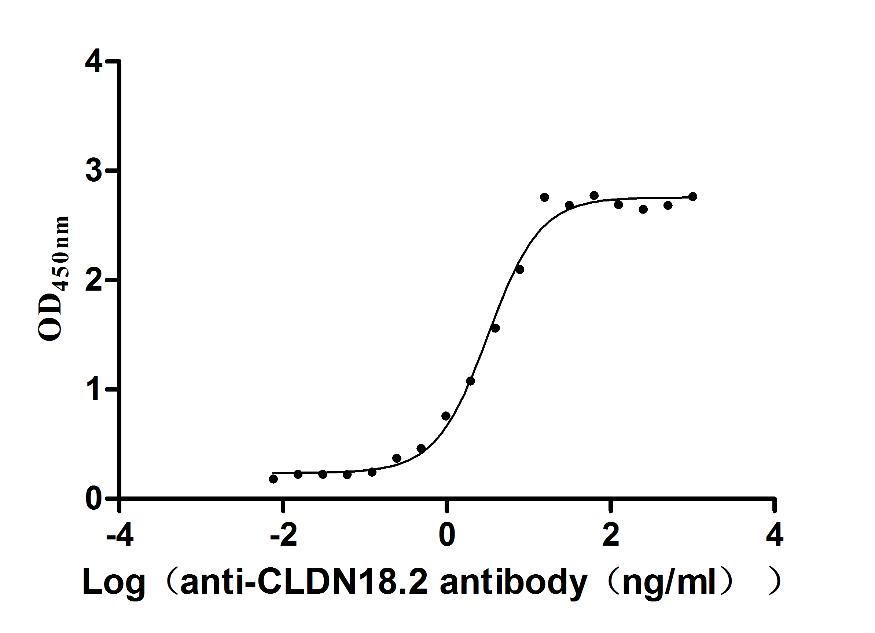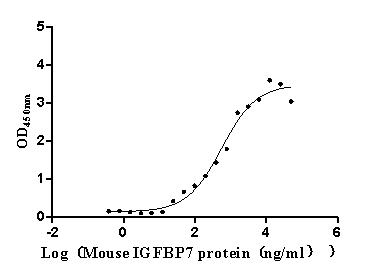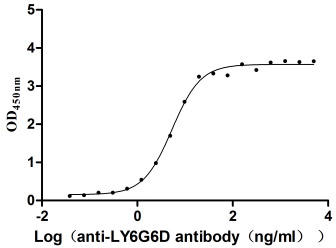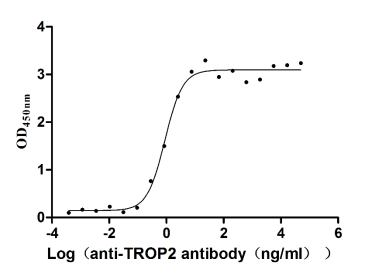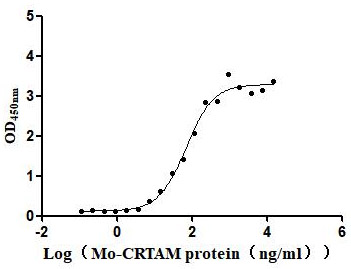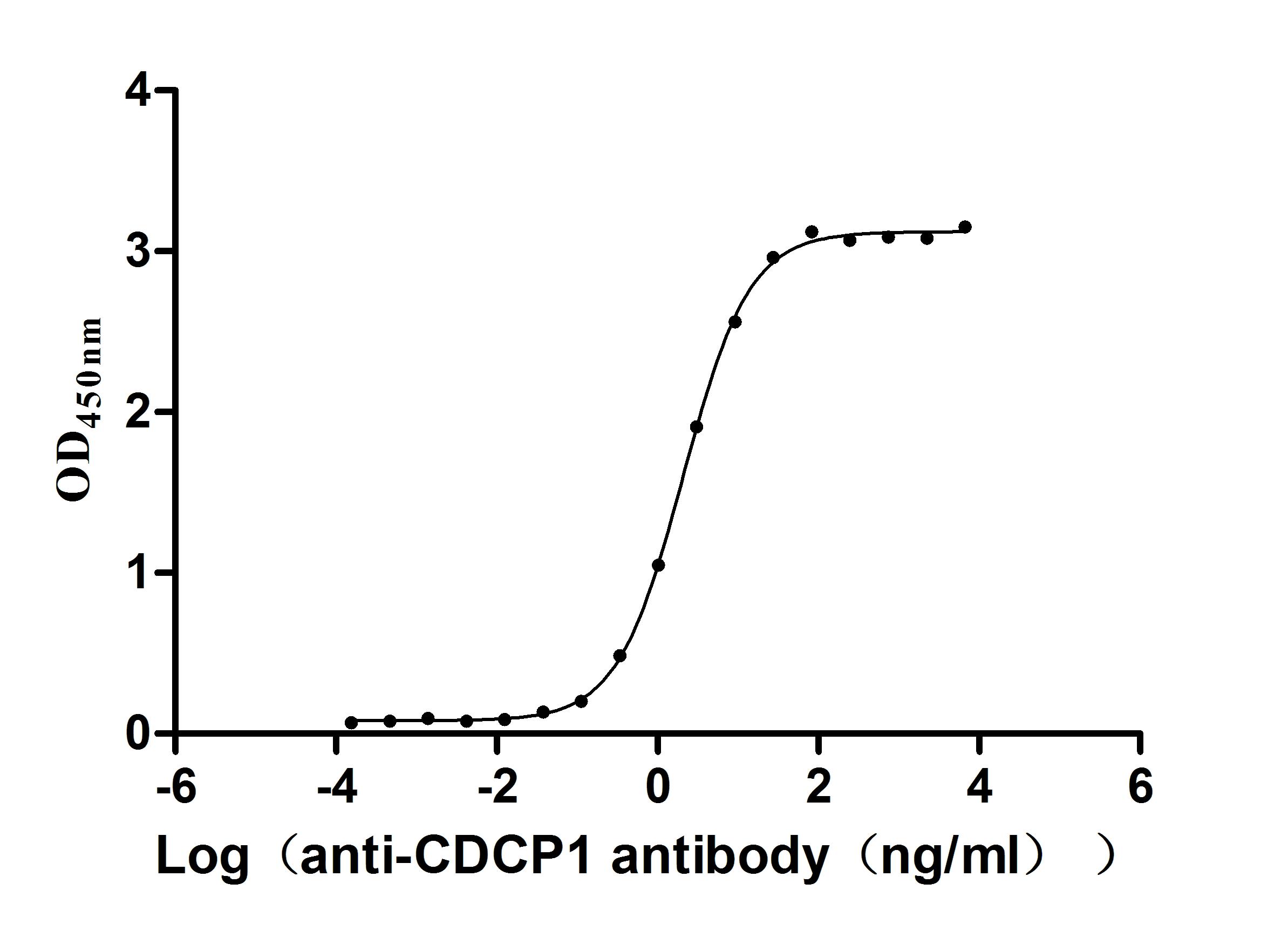Recombinant Mouse Interferon-induced helicase C domain-containing protein 1 (Ifih1), partial
In Stock-
中文名稱:小鼠Ifih1重組蛋白
-
貨號:CSB-EP819199MO
-
規(guī)格:¥2328
-
圖片:
-
其他:
產(chǎn)品詳情
-
純度:Greater than 85% as determined by SDS-PAGE.
-
基因名:
-
Uniprot No.:
-
別名:Helicase with 2 CARD domains;Helicard;Interferon induced with helicase C domain protein 1;Melanoma differentiation-associated protein 5;MDA-5;RIG-I-like receptor 2;RLR-2
-
種屬:Mus musculus (Mouse)
-
蛋白長度:Partial
-
來源:E.coli
-
分子量:41.5 kDa
-
表達區(qū)域:700-1025aa
-
氨基酸序列KLIKLRNTILEQFTRSEESSRGIIFTKTRQSTYALSQWIMENAKFAEVGVKAHHLIGAGHSSEVKPMTQTEQKEVISKFRTGEINLLIATTVAEEGLDIKECNIVIRYGLVTNEIAMVQARGRARADESTYVLVTSSGSGVTEREIVNDFREKMMYKAINRVQNMKPEEYAHKILELQVQSILEKKMKVKRSIAKQYNDNPSLITLLCKNCSMLVCSGENIHVIEKMHHVNMTPEFKGLYIVRENKALQKKFADYQTNGEIICKCGQAWGTMMVHKGLDLPCLKIRNFVVNFKNNSPKKQYKKWVELPIRFPDLDYSEYCLYSDED
Note: The complete sequence may include tag sequence, target protein sequence, linker sequence and extra sequence that is translated with the protein sequence for the purpose(s) of secretion, stability, solubility, etc.
If the exact amino acid sequence of this recombinant protein is critical to your application, please explicitly request the full and complete sequence of this protein before ordering. -
蛋白標簽:N-terminal 6xHis-tagged
-
產(chǎn)品提供形式:Liquid or Lyophilized powder
Note: We will preferentially ship the format that we have in stock, however, if you have any special requirement for the format, please remark your requirement when placing the order, we will prepare according to your demand. -
緩沖液:If the delivery form is liquid, the default storage buffer is Tris/PBS-based buffer, 5%-50% glycerol. If the delivery form is lyophilized powder, the buffer before lyophilization is Tris/PBS-based buffer, 6% Trehalose.
-
復溶:We recommend that this vial be briefly centrifuged prior to opening to bring the contents to the bottom. Please reconstitute protein in deionized sterile water to a concentration of 0.1-1.0 mg/mL.We recommend to add 5-50% of glycerol (final concentration) and aliquot for long-term storage at -20°C/-80°C. Our default final concentration of glycerol is 50%. Customers could use it as reference.
-
儲存條件:Store at -20°C/-80°C upon receipt, aliquoting is necessary for mutiple use. Avoid repeated freeze-thaw cycles.
-
保質期:The shelf life is related to many factors, storage state, buffer ingredients, storage temperature and the stability of the protein itself.
Generally, the shelf life of liquid form is 6 months at -20°C/-80°C. The shelf life of lyophilized form is 12 months at -20°C/-80°C. -
貨期:3-7 business days
-
注意事項:Repeated freezing and thawing is not recommended. Store working aliquots at 4°C for up to one week.
-
Datasheet & COA:Please contact us to get it.
相關產(chǎn)品
靶點詳情
-
功能:Innate immune receptor which acts as a cytoplasmic sensor of viral nucleic acids and plays a major role in sensing viral infection and in the activation of a cascade of antiviral responses including the induction of type I interferons and proinflammatory cytokines. Its ligands include mRNA lacking 2'-O-methylation at their 5' cap and long-dsRNA (>1 kb in length). Upon ligand binding it associates with mitochondria antiviral signaling protein (MAVS/IPS1) which activates the IKK-related kinases: TBK1 and IKBKE which phosphorylate interferon regulatory factors: IRF3 and IRF7 which in turn activate transcription of antiviral immunological genes, including interferons (IFNs); IFN-alpha and IFN-beta. Responsible for detecting the Picornaviridae family members such as encephalomyocarditis virus (EMCV), mengo encephalomyocarditis virus (ENMG), and theiler's murine encephalomyelitis virus (TMEV). Can also detect other viruses such as dengue virus (DENV), west Nile virus (WNV), and reovirus. Also involved in antiviral signaling in response to viruses containing a dsDNA genome, such as vaccinia virus. Plays an important role in amplifying innate immune signaling through recognition of RNA metabolites that are produced during virus infection by ribonuclease L (RNase L). May play an important role in enhancing natural killer cell function and may be involved in growth inhibition and apoptosis in several tumor cell lines.
-
基因功能參考文獻:
- findings indicate a possible role of PACT in regulating the Cardiovirus-triggered immune responses mediated by MDA5 and LGP2 PMID: 29032202
- These findings imply that MDA5-induced cell death and inflammation in the pancreas facilitate progression to autoimmune destruction of pancreatic beta-cells. PMID: 28851763
- Mice with a knock-in mutation encoding IFIH1(T946) displayed enhanced basal expression of type I interferons, survived a lethal viral challenge and exhibited increased penetrance in autoimmune models, including a combinatorial effect with other risk variants. Furthermore, IFIH1(T946) mice manifested an embryonic survival defect consistent with enhanced responsiveness to RNA self ligands. PMID: 28553952
- TRIM65 as an essential component for the MDA5 signaling pathway and provide physiological evidence showing that ubiquitination is important for MDA5 oligomerization and activation. PMID: 28031478
- MDA-5 stimulation leads to endothelial dysfunction. PMID: 27130701
- The p150 isoform of ADAR1 uniquely regulated the MDA5 pathway. PMID: 26588779
- MDA5, detects viral RNA and triggers induction of type I interferons, chemical messengers that induce inflammation and help regulate the immune responses. PMID: 26423942
- Duox2-derived reactive oxygen species are necessary for the innate immune response and trigger the induction of RIG-I and MDA5 to resist influenza A infection in human nasal epithelium and mouse nasal mucosa. PMID: 25751630
- L region antisense RNA of EMCV is a key determinant of innate immunity to the virus and represents an RNA that activates LGP2 associated MDA5 in virally-infected cells. PMID: 24550253
- embryonic death and phenotypes of Adar1(E861A/E861A) were rescued by concurrent deletion of the cytosolic sensor of dsRNA, MDA5. PMID: 26275108
- IFIH1 heterozygous mice have a regulatory rather than effector T-cell response at the site of autoimmunity, supporting IFIH1 expression as an essential regulator of the diabetogenic T-cell response. PMID: 25591872
- Our results, therefore, suggest that Arl5B is a negative regulator for MDA5. PMID: 25451939
- TRIM13 interacts with MDA5 and negatively regulates MDA5-mediated type I IFN production PMID: 25008915
- RIG-I and MDA-5 detection of viral RNA-dependent RNA polymerase activity restricts positive-strand RNA virus replication. PMID: 24039580
- MDA5 modulates the development of chronic lung inflammation by regulating the early inflammatory response in the lung. PMID: 24417465
- These results strongly suggest that RIG-I and MDA5 participate in innate antiviral responses in cochlear tissue. PMID: 23644230
- These studies suggest that MDA5 in the immune priming environment shapes optimal CD8(+) T cell activation and subsequent clearance of West Nile virus from the central nervous system. PMID: 23966390
- Thus, RIG-I and MDA5 are essential pattern recognition receptors that recognize distinct pathogen-associated molecular patterns that accumulate during West Nile virus replication. PMID: 23966395
- Collectively, our in vitro and in vivo studies both support a critical role for MDA5 in the innate immune response against hepatitis B virus infection. PMID: 23926323
- these findings suggest that mast cells produce cytokines and chemokines in the early infection stage after recognizing viruses via RIG-I and MDA5, and may contribute to antiviral responses PMID: 23171655
- MDA5 localization to stress granules is not required for the induction of interferon alpha and beta during mengovirus infection PMID: 23536668
- Myocardial MDA5 may be a key molecule in protecting the heart from direct viral injury and myocardial dysfunction. PMID: 23271791
- MDA5 is a polymerization-dependent signaling platform that uses the amyloid-like self-propagating properties of mitochondrial antiviral-signaling protein to amplify signaling. PMID: 23090998
- Pretreatment of mice with melanoma differentiation-associated gene 5 (MDA5) and IFN-beta promoter stimulator-1 ASOs. PMID: 22505629
- MDA5 overexpression led to a chronic IFN-I state characterized by resistance to a lethal viral infection through rapid clearance of virus in the absence of a CD8(+) or Ab response PMID: 22205024
- It was shown that MDA5 cooperatively binds short RNA ligands as a dimer with a 16-18-basepair footprint. A crystal structure of the MDA5 helicase-insert domain demonstrates an evolutionary relationship with the archaeal Hef helicases. PMID: 22314235
- However, only MDA5 interacted with the V protein dependently on the C-terminal V unique (Vu) region, inhibiting IRF3 reporter activation. PMID: 21851384
- MDA5 and TLR3 initiate pro-inflammatory signaling pathways leading to rhinovirus-induced airways inflammation and hyperresponsiveness. PMID: 21637773
- Signaling through melanoma differentiation-associated (MDA)5 and RIG-I controls rotavirus production in intestinal epithelial cells. PMID: 21187438
- These results demonstrate that mouse hepatitis virus is recognized by both RIG-I and MDA5 and induces IFN-alpha/beta through the activation of the IRF-3 signaling pathway. PMID: 20427526
- MDA-5 plays an important role in the host immune response to CVB3 by preventing early virus replication and limiting tissue pathology. PMID: 20206372
- MDA5 and Toll-like receptor 3 mediate substantially distinct yet complementary functions during polyinosinic:polycytidylic acid (poly I-C)-mediated activation of antigen-specific CD8 T cell responses. PMID: 20164430
- These findings indicate that changes in MDA5 and PTPN2 expression modify beta-cell responses to dsRNA. PMID: 19825843
- data suggest that LGP2 facilitates viral RNA recognition by RIG-I and MDA5 through its ATPase domain. PMID: 20080593
- MDA5 is indispensable for sustained expression of IFN in response to paramyxovirus infection PMID: 20107606
- Two RNA-sensing proteins, RIG-I and MDA5, participate in the IFN response to Legionella pneumophila. PMID: 19936053
- stimulation with RNA viruses encephalomyocarditis virus and Sendai virus specifically activates MDA5 and RIG-I, blocking Treg cell function PMID: 19966212
- MDA5 and its adaptor molecule MAVS are critical for type I interferon responses to CVB; the absence of either MAVS or MDA5 leads to deficient type I interferon production and early mortality PMID: 19846534
- Data show that viral RNA stimulates glomerular mesangial cells to produce large amounts of type I IFN, especially when being delivered into the intracellular cytosol where it can interact with Mda5. PMID: 19850889
- Shared and unique functions of the DExD/H-box helicases RIG-I, MDA5, and LGP2 in antiviral innate immunity. PMID: 16116171
- RIG-I is essential for the production of interferons in response to RNA viruses including paramyxoviruses, influenza virus and Japanese encephalitis virus, whereas MDA5 is critical for picornavirus detection PMID: 16625202
- mda-5-/- mice exhibited a selectively impaired antiviral response to encephalomyocarditis picornavirus, indicating functional specialization of mda-5 in vivo PMID: 16714379
- These observations demonstrate differential and redundant roles for RIG-I and MDA5 in pathogen recognition and innate immune signaling. PMID: 17942531
- RIG-I and MDA5 are responsible for triggering downstream gene expression in response to West Nile Virus infection by signaling through IPS-1. PMID: 17977974
- offer biological relevance to the previously reported inhibition of MDA5 by different paramyxovirus V proteins PMID: 18354215
- Collectively, RIG-I detects dsRNAs without a 5'-triphosphate end, and RIG-I and MDA5 selectively recognize short and long dsRNAs, respectively. PMID: 18591409
- Data suggest that mouse hepatitis virus induces type I interferon in macrophages and microglia in the brain and is recognized by an MDA5-dependent pathway in macrophages. PMID: 18667505
- Astrocytes recognize intracellular poly I-C via MDA-5. PMID: 19036857
- activation of the virus-sensing MDA-5 receptor leads to a rapid and reversible involution of the thymus PMID: 19414755
- two RIG-I-like receptors (RLRs), RIG-I and MDA5, known as cytosolic RNA receptors, nonredundantly function as cytosolic DNA receptors that lead to the selective activation of type I IFN genes PMID: 19805092
顯示更多
收起更多
-
亞細胞定位:Cytoplasm. Nucleus. Mitochondrion.
-
蛋白家族:Helicase family, RLR subfamily
-
組織特異性:Expression is prominent in lung, liver, kidney, heart and spleen (at protein level). Widely expressed at low level.
-
數(shù)據(jù)庫鏈接:
Most popular with customers
-
Recombinant Human Retinol-binding protein 4 (RBP4) (Active)
Express system: Mammalian cell
Species: Homo sapiens (Human)
-
Recombinant Mouse Tyrosine-protein kinase Mer (Mertk), partial (Active)
Express system: Mammalian cell
Species: Mus musculus (Mouse)
-
Recombinant Macaca fascicularis Claudin 18.2 (CLDN18.2)-VLPs (Active)
Express system: Mammalian cell
Species: Macaca fascicularis (Crab-eating macaque) (Cynomolgus monkey)
-
Recombinant Mouse Complement component C1q receptor (Cd93), partial (Active)
Express system: Mammalian cell
Species: Mus musculus (Mouse)
-
Recombinant Macaca fascicularis lymphocyte antigen 6 family member G6D (LY6G6D) (Active)
Express system: Yeast
Species: Macaca fascicularis (Crab-eating macaque) (Cynomolgus monkey)
-
Recombinant Human Tumor-associated calcium signal transducer 2 (TACSTD2), partial (Active)
Express system: Mammalian cell
Species: Homo sapiens (Human)
-
Recombinant Mouse Cell adhesion molecule 1 (Cadm1), partial (Active)
Express system: Mammalian cell
Species: Mus musculus (Mouse)
-
Recombinant Macaca fascicularis CUB domain containing protein 1 (CDCP1), partial (Active)
Express system: Mammalian cell
Species: Macaca fascicularis (Crab-eating macaque) (Cynomolgus monkey)

